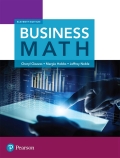
EBK BUSINESS MATH
11th Edition
ISBN: 8220103632072
Author: NOBLE
Publisher: Pearson Education (US)
expand_more
expand_more
format_list_bulleted
Concept explainers
Question
Chapter 20.2, Problem 2-3SC
To determine
To calculate: The amount of tax paid by Reggie Howard if assessed value is
Expert Solution & Answer
Want to see the full answer?
Check out a sample textbook solution
Students have asked these similar questions
Use Laplace transform and convolution theorem to solve the initial value problem
y' + y = tsint, y(0) = 0
Please use the infinite series formula and specify how you did each step. Thank you.
In a small office, there are m = 5 typists who need to use a single typewriter to complete their reports. Assume the time
each typist takes to prepare a report follows an exponential distribution with an average of 20 minutes per preparation
(A = 3 reports/hour), and the service time for the typewriter to type out a report also follows an exponential distribution,
averaging 30 minutes to complete a report (μ 2 reports/hour). Given that the number of typists is finite and all typists
=
share one typewriter, they will form a waiting queue.
(1). Describe this queuing system and explain how it fits the characteristics of the M/M/1/∞0/m model.
(2). Calculate the probability that any typist is using the typewriter at steady-state.
(3). Calculate the average number of typists waiting in the queue at steady-state.
(4). Considering the need to reduce waiting time, if an additional typewriter is introduced (turning into a two-server
system, or M/M/2/∞0/m model), analyze the expected impact,…
Chapter 20 Solutions
EBK BUSINESS MATH
Ch. 20.1 - Prob. 1-1SCCh. 20.1 - Prob. 1-2SCCh. 20.1 - Prob. 1-3SCCh. 20.1 - Prob. 1-4SCCh. 20.1 - Prob. 1-5SCCh. 20.1 - Prob. 1-6SCCh. 20.1 - Prob. 2-1SCCh. 20.1 - Prob. 2-2SCCh. 20.1 - Prob. 2-3SCCh. 20.1 - Prob. 2-4SC
Ch. 20.1 - Prob. 1SECh. 20.1 - Prob. 2SECh. 20.1 - Prob. 3SECh. 20.1 - Prob. 4SECh. 20.1 - Prob. 5SECh. 20.1 - Prob. 6SECh. 20.1 - Prob. 7SECh. 20.1 - Prob. 8SECh. 20.1 - Prob. 9SECh. 20.1 - Prob. 10SECh. 20.1 - Prob. 11SECh. 20.1 - Prob. 12SECh. 20.1 - Prob. 13SECh. 20.1 - Prob. 14SECh. 20.1 - Prob. 15SECh. 20.1 - Prob. 16SECh. 20.1 - Prob. 17SECh. 20.1 - Prob. 18SECh. 20.1 - Prob. 19SECh. 20.1 - Prob. 20SECh. 20.2 - Prob. 1-1SCCh. 20.2 - Prob. 1-2SCCh. 20.2 - Prob. 1-3SCCh. 20.2 - Prob. 1-4SCCh. 20.2 - Prob. 2-1SCCh. 20.2 - Prob. 2-2SCCh. 20.2 - Prob. 2-3SCCh. 20.2 - Prob. 2-4SCCh. 20.2 - Prob. 3-1SCCh. 20.2 - Prob. 3-2SCCh. 20.2 - Prob. 3-3SCCh. 20.2 - Prob. 3-4SCCh. 20.2 - Prob. 3-5SCCh. 20.2 - Prob. 3-6SCCh. 20.2 - Prob. 1SECh. 20.2 - Prob. 2SECh. 20.2 - Prob. 3SECh. 20.2 - Prob. 4SECh. 20.2 - Prob. 5SECh. 20.2 - Prob. 6SECh. 20.2 - Prob. 7SECh. 20.2 - Prob. 8SECh. 20.2 - Prob. 9SECh. 20.2 - Prob. 10SECh. 20.2 - Prob. 11SECh. 20.2 - Prob. 12SECh. 20.2 - Prob. 13SECh. 20.2 - Prob. 14SECh. 20.2 - Prob. 15SECh. 20.2 - Prob. 16SECh. 20.2 - Prob. 17SECh. 20.2 - Prob. 18SECh. 20.2 - Prob. 19SECh. 20.2 - Prob. 20SECh. 20.2 - Prob. 21SECh. 20.2 - Prob. 22SECh. 20.2 - Prob. 23SECh. 20.3 - Prob. 1-1SCCh. 20.3 - Prob. 1-2SCCh. 20.3 - Prob. 1-3SCCh. 20.3 - Prob. 1-4SCCh. 20.3 - Prob. 2-1SCCh. 20.3 - Prob. 2-2SCCh. 20.3 - Prob. 2-3SCCh. 20.3 - Prob. 2-4SCCh. 20.3 - Prob. 3-1SCCh. 20.3 - Prob. 3-2SCCh. 20.3 - Prob. 3-3SCCh. 20.3 - Prob. 3-4SCCh. 20.3 - Prob. 1SECh. 20.3 - Prob. 2SECh. 20.3 - Prob. 3SECh. 20.3 - Prob. 4SECh. 20.3 - Prob. 5SECh. 20.3 - Prob. 6SECh. 20.3 - Prob. 7SECh. 20.3 - Prob. 8SECh. 20.3 - Prob. 9SECh. 20.3 - Prob. 10SECh. 20.3 - Prob. 11SECh. 20.3 - Prob. 12SECh. 20.3 - Prob. 13SECh. 20.3 - Prob. 14SECh. 20.3 - Prob. 15SECh. 20.3 - Prob. 16SECh. 20.3 - Prob. 17SECh. 20.3 - Prob. 18SECh. 20.3 - Prob. 19SECh. 20.3 - Prob. 20SECh. 20 - Prob. 1ESCh. 20 - Prob. 2ESCh. 20 - Prob. 3ESCh. 20 - Prob. 4ESCh. 20 - Prob. 5ESCh. 20 - Prob. 6ESCh. 20 - Prob. 7ESCh. 20 - Prob. 8ESCh. 20 - Prob. 9ESCh. 20 - Prob. 10ESCh. 20 - Prob. 11ESCh. 20 - Prob. 12ESCh. 20 - Prob. 13ESCh. 20 - Prob. 14ESCh. 20 - Prob. 15ESCh. 20 - Prob. 16ESCh. 20 - Prob. 17ESCh. 20 - Prob. 18ESCh. 20 - Prob. 19ESCh. 20 - Prob. 20ESCh. 20 - Prob. 21ESCh. 20 - Prob. 22ESCh. 20 - Prob. 23ESCh. 20 - Prob. 24ESCh. 20 - Prob. 25ESCh. 20 - Prob. 26ESCh. 20 - Prob. 27ESCh. 20 - Prob. 28ESCh. 20 - Prob. 29ESCh. 20 - Prob. 30ESCh. 20 - Prob. 31ESCh. 20 - Prob. 32ESCh. 20 - Prob. 33ESCh. 20 - Prob. 34ESCh. 20 - Prob. 35ESCh. 20 - Prob. 36ESCh. 20 - Prob. 37ESCh. 20 - Prob. 38ESCh. 20 - Prob. 39ESCh. 20 - Prob. 40ESCh. 20 - Prob. 41ESCh. 20 - Prob. 42ESCh. 20 - Prob. 43ESCh. 20 - Prob. 44ESCh. 20 - Prob. 45ESCh. 20 - Prob. 46ESCh. 20 - Prob. 47ESCh. 20 - Prob. 48ESCh. 20 - Prob. 49ESCh. 20 - Prob. 50ESCh. 20 - Prob. 51ESCh. 20 - Prob. 52ESCh. 20 - Prob. 53ESCh. 20 - Prob. 54ESCh. 20 - Prob. 55ESCh. 20 - Prob. 56ESCh. 20 - Prob. 57ESCh. 20 - Prob. 58ESCh. 20 - Prob. 59ESCh. 20 - Prob. 60ESCh. 20 - Prob. 61ESCh. 20 - Prob. 62ESCh. 20 - Prob. 63ESCh. 20 - Prob. 64ESCh. 20 - Prob. 65ESCh. 20 - Prob. 66ESCh. 20 - Prob. 67ESCh. 20 - Prob. 68ESCh. 20 - Prob. 69ESCh. 20 - Prob. 70ESCh. 20 - Prob. 71ESCh. 20 - Prob. 72ESCh. 20 - Prob. 1PTCh. 20 - Prob. 2PTCh. 20 - Prob. 3PTCh. 20 - Prob. 4PTCh. 20 - Prob. 5PTCh. 20 - Prob. 6PTCh. 20 - Prob. 7PTCh. 20 - Prob. 8PTCh. 20 - Prob. 9PTCh. 20 - Prob. 10PTCh. 20 - Prob. 11PTCh. 20 - Prob. 12PTCh. 20 - Prob. 13PTCh. 20 - Prob. 14PTCh. 20 - Prob. 15PTCh. 20 - Prob. 16PTCh. 20 - Prob. 17PTCh. 20 - Prob. 18PTCh. 20 - Prob. 19PTCh. 20 - Prob. 20PTCh. 20 - Prob. 21PTCh. 20 - Prob. 22PTCh. 20 - Prob. 1CTCh. 20 - Prob. 2CTCh. 20 - Prob. 3CTCh. 20 - Prob. 4CTCh. 20 - Prob. 5CTCh. 20 - Prob. 6CTCh. 20 - Prob. 7CTCh. 20 - Prob. 8CTCh. 20 - Prob. 1CPCh. 20 - Prob. 2CPCh. 20 - Prob. 1CS1Ch. 20 - Prob. 2CS1Ch. 20 - Prob. 3CS1Ch. 20 - Prob. 4CS1Ch. 20 - Prob. 1CS2Ch. 20 - Prob. 2CS2Ch. 20 - Prob. 3CS2Ch. 20 - Prob. 4CS2
Knowledge Booster
Learn more about
Need a deep-dive on the concept behind this application? Look no further. Learn more about this topic, subject and related others by exploring similar questions and additional content below.Similar questions
- Use Laplace transform to solve the initial value problem y' + y = tsin(t), y(0) = 0arrow_forwardThe function g is defined by g(x) = sec² x + tan x. What are all solutions to g(x) = 1 on the interval 0 ≤ x ≤ 2π ? A x = = 0, x == = 3, x = π, x = 7 4 , 4 and x 2π only = B x = 4' 1, x = 1, x = 57 and x = 3 only C x = πk and x = - +πk D , where is any integer П x = +πk and П x = +πk, where k is any integerarrow_forwardBusiness discussarrow_forward
- Vector v = PQ has initial point P (2, 14) and terminal point Q (7, 3). Vector v = RS has initial point R (29, 8) and terminal point S (12, 17). Part A: Write u and v in linear form. Show all necessary work. Part B: Write u and v in trigonometric form. Show all necessary work. Part C: Find 7u − 4v. Show all necessary calculations.arrow_forwardAn object is suspended by two cables attached at a single point. The force applied on one cable has a magnitude of 125 pounds and acts at an angle of 37°. The force on the other cable is 75 pounds at an angle of 150°.Part A: Write each vector in component form. Show all necessary work.Part B: Find the dot product of the vectors. Show all necessary calculations Part C: Use the dot product to find the angle between the cables. Round the answer to the nearest degree. Show all necessary calculations.arrow_forwardAn airplane flies at 500 mph with a direction of 135° relative to the air. The plane experiences a wind that blows 60 mph with a direction of 60°.Part A: Write each of the vectors in linear form. Show all necessary calculations.Part B: Find the sum of the vectors. Show all necessary calculations. Part C: Find the true speed and direction of the airplane. Round the speed to the thousandths place and the direction to the nearest degree. Show all necessary calculations.arrow_forward
- Use sigma notation to write the sum. Σ EM i=1 - n 2 4n + n narrow_forwardVectors t = 3i + 7j, u = 2i − 5j, and v = −21i + 9j are given.Part A: Find the angle between vectors t and u. Show all necessary calculations. Part B: Choose a value for c, such that c > 1. Find w = cv. Show all necessary work.Part C: Use the dot product to determine if t and w are parallel, orthogonal, or neither. Justify your answer.arrow_forwardKindly inform what is bottling?arrow_forward
- Business discussarrow_forward8) Solve the given system using the Gaussian Elimination process. 2x8y = 3 (-6x+24y = −6arrow_forwardA small company of science writers found that its rate of profit (in thousands of dollars) after t years of operation is given by P'(t) = (5t + 15) (t² + 6t+9) ³. (a) Find the total profit in the first three years. (b) Find the profit in the sixth year of operation. (c) What is happening to the annual profit over the long run? (a) The total profit in the first three years is $ (Round to the nearest dollar as needed.)arrow_forward
arrow_back_ios
SEE MORE QUESTIONS
arrow_forward_ios
Recommended textbooks for you

 Holt Mcdougal Larson Pre-algebra: Student Edition...AlgebraISBN:9780547587776Author:HOLT MCDOUGALPublisher:HOLT MCDOUGAL
Holt Mcdougal Larson Pre-algebra: Student Edition...AlgebraISBN:9780547587776Author:HOLT MCDOUGALPublisher:HOLT MCDOUGAL College Algebra (MindTap Course List)AlgebraISBN:9781305652231Author:R. David Gustafson, Jeff HughesPublisher:Cengage Learning
College Algebra (MindTap Course List)AlgebraISBN:9781305652231Author:R. David Gustafson, Jeff HughesPublisher:Cengage Learning Glencoe Algebra 1, Student Edition, 9780079039897...AlgebraISBN:9780079039897Author:CarterPublisher:McGraw Hill
Glencoe Algebra 1, Student Edition, 9780079039897...AlgebraISBN:9780079039897Author:CarterPublisher:McGraw Hill Elementary AlgebraAlgebraISBN:9780998625713Author:Lynn Marecek, MaryAnne Anthony-SmithPublisher:OpenStax - Rice University
Elementary AlgebraAlgebraISBN:9780998625713Author:Lynn Marecek, MaryAnne Anthony-SmithPublisher:OpenStax - Rice University Algebra: Structure And Method, Book 1AlgebraISBN:9780395977224Author:Richard G. Brown, Mary P. Dolciani, Robert H. Sorgenfrey, William L. ColePublisher:McDougal Littell
Algebra: Structure And Method, Book 1AlgebraISBN:9780395977224Author:Richard G. Brown, Mary P. Dolciani, Robert H. Sorgenfrey, William L. ColePublisher:McDougal Littell


Holt Mcdougal Larson Pre-algebra: Student Edition...
Algebra
ISBN:9780547587776
Author:HOLT MCDOUGAL
Publisher:HOLT MCDOUGAL

College Algebra (MindTap Course List)
Algebra
ISBN:9781305652231
Author:R. David Gustafson, Jeff Hughes
Publisher:Cengage Learning

Glencoe Algebra 1, Student Edition, 9780079039897...
Algebra
ISBN:9780079039897
Author:Carter
Publisher:McGraw Hill

Elementary Algebra
Algebra
ISBN:9780998625713
Author:Lynn Marecek, MaryAnne Anthony-Smith
Publisher:OpenStax - Rice University

Algebra: Structure And Method, Book 1
Algebra
ISBN:9780395977224
Author:Richard G. Brown, Mary P. Dolciani, Robert H. Sorgenfrey, William L. Cole
Publisher:McDougal Littell
What is a Linear Equation in One Variable?; Author: Don't Memorise;https://www.youtube.com/watch?v=lDOYdBgtnjY;License: Standard YouTube License, CC-BY
Linear Equation | Solving Linear Equations | What is Linear Equation in one variable ?; Author: Najam Academy;https://www.youtube.com/watch?v=tHm3X_Ta_iE;License: Standard YouTube License, CC-BY